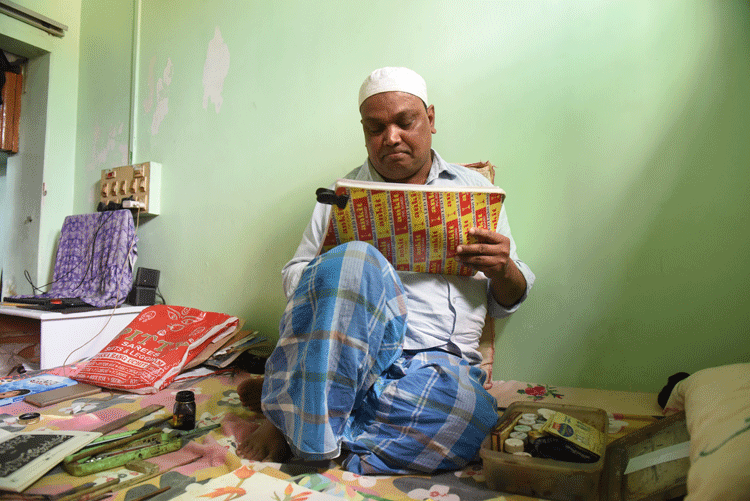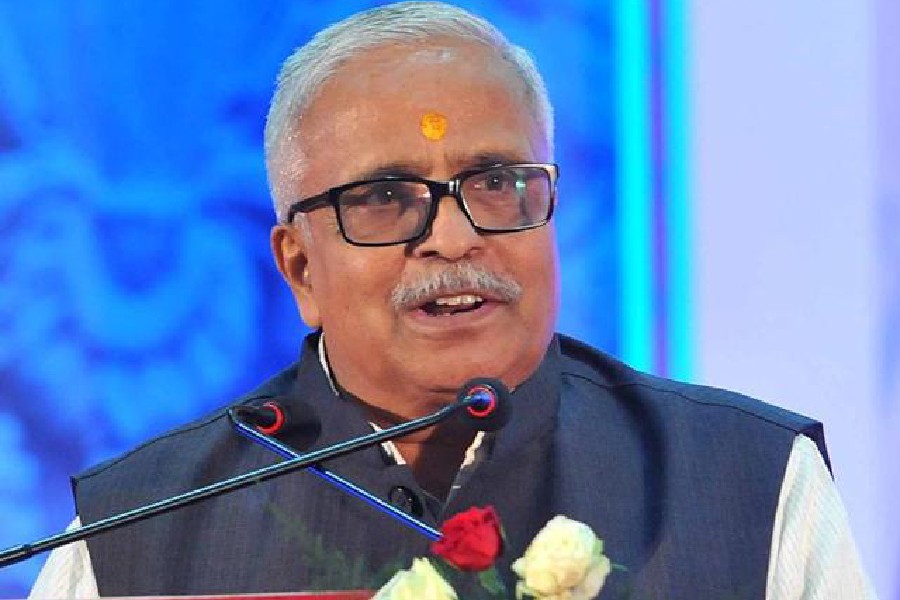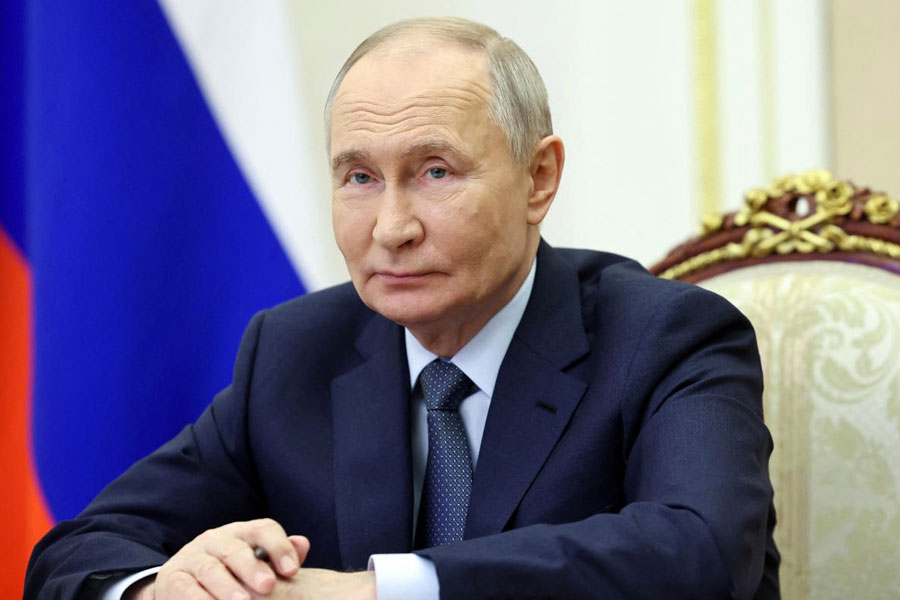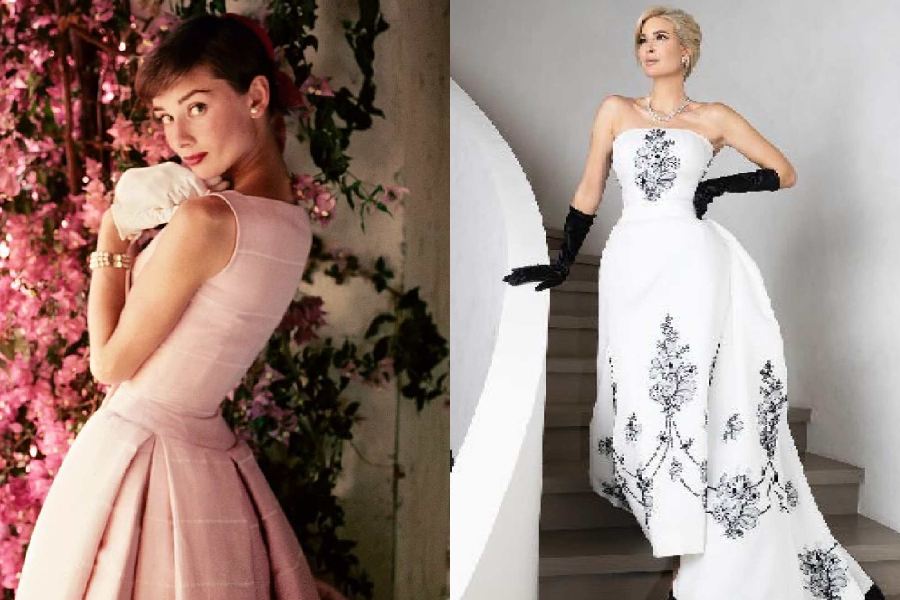Mohammad Usman Ghani hurries out of a crowded, narrow lane of Belgachhia Children’s Park area, a Muslim locality next to Belgachhia Urdu High School. He greets me warmly and guides me to his house in the lane. “Garib ka ghar hai,” he says apologetically, more than once.
The small room I am ushered into is occupied almost entirely by a double bed, which is his workplace. On it lie books and sheaves of paper in little piles, and a batch of wooden pens with wooden or metal nibs. A showcase stands against one wall and a desktop computer is wedged into a corner. Outside, small children shout and play, sometimes making a quick entry into the room, then a quicker exit.
As one approaches Ghani’s locality, one can see a few anti-CAA and anti-NRC posters.
Amidst all this bustle, Ghani, 38, sits quietly on his bed, his skullcap-covered head bent over a piece of paper that is filling up with beautiful Urdu lettering. Ghani is a calligrapher. The Urdu script, with its curves and swirls, is in itself quite lyrical. Urdu calligraphy, its more concentrated, cursive and complex form, is at its best like distilled poetry.
Ghani was drawn to this centuries-old art from a very early age. He was moved by its beauty. It is a very fine, elaborate and demanding art, he explains, in which every dot, dash or curl, if decorative, is also part of the lettering, and in a master’s hand they come together to fuse into an exquisite design. An ordinary name becomes a work of art.
“I was born here,” says Ghani. He first studied at the corporation school in the area, then went on to study at Mohammad Jan High School in Burrabazar. He studied for his master’s degree at Hyderabad Maulana Azad National Urdu University, passing out in 2008.
But after school, he had first enrolled at Urdu Academy in Calcutta to learn calligraphy along with graphic design. He teaches calligraphy at the academy now.
At home, he works on books, banners and signboards, but also on stone plaques for masjids or for homes, quite often with excerpts of The Quran in them. Calligraphy is central, sometimes literally, to Islamic architecture. “The gates of Taj Mahal are framed with calligraphy,” reminds Ghani.
But that is Arabic, he says. To understand the idea of Urdu calligraphy, one also has to understand the idea of Arabic calligraphy. Ghani practises both.
“A calligrapher is called a katib in Urdu. The wooden nib of the pen is called a sarkanda or a klich,” he says. They can be reed pens too. “The point is called a noqta. The curve is called a dayra,” Ghani adds. “Everything has a name,” he smiles. “How many can I name?” The elaborate terminology of calligraphy also explains how intricate the art is.
The artist M.F. Husain had trained in calligraphy, he reminds.
Arabic calligraphy, from which Urdu calligraphy evolved, was authored in the 10th century by Ibn Muqla, a Persian high official who later became a vizier in Baghdad, explains Ghani. He designed six styles. “Or fonts,” says Ghani.
Urdu calligraphy was formalised between 1330 and 1405, after Islam reached parts of India, in the Nashtaliq font by Khwaja Mir Ali Tabrezi. Urdu, the language too, was developing then from Khariboli, a north Indian dialect that had borrowed heavily from Persian words. “Urdu calligraphy uses eight fonts,” says Ghani.
Ghani cannot express enough gratitude to his two masters, ustads, Ghulam Murtaza and Wasey Ahmed.
To illustrate the differences between Arabic and Urdu further, Ghani brings out a pen and dips it in the special ink. Previously the ink would be manufactured by the calligrapher himself by burning wood, but now it can be bought. “For Urdu calligraphy, the pen has to be held at 63 degrees. For Arabic, at 75 degrees. In Urdu, the dayra is circular or oval. In Arabic, it is differently shaped.”
He offers to rewrite an Urdu phrase calligraphically and chooses a heading of a book of which he had composed the title in calligraphy.
“But Urdu is the language of love, of poetry,” he says. He begins to write on another piece of paper Faiz Ahmed Faiz’s ghazal: “Gulon mein rang bhare, baad-e-naubahaar chale/Chale bhii aao ki gulshan kaa karobaar chale… (May the flowers fill up with colours, may the early spring breeze start blowing again/ Please come back, so that the garden can resume its business again…).”
I later discover that the song was written when Faiz, a Communist, was thrown into prison in Pakistan in the 1950s for his political views. The ghazal, sung by Mehdi Hassan, was also used by Vishal Bharadwaj in his searing 2014 film on Kashmir, Haider.
But Ghani, since he is using calligraphy, selects only the first two lines, and transforms them into a sher, a couplet, and a love poem. For him, it is about the intense longing for the beloved.
Of course, the computer has changed calligraphy. Not too many calligraphers are to be found easily. “But the computer cannot do what the hand can do,” says Ghani. His work on books now mostly mean writing the title of the book in Urdu calligraphy. The rest of the text is composed on the computer.
“The keywords are composed by handwritten calligraphy,” says Ghani. Same for wedding cards, where the names of the bride and groom are written calligraphically; the rest is computer-generated. “The two are never the same,” stresses Ghani.
To supplement his income, he works at the computer himself. He, too, makes wedding cards, with the calligraphy done by hand and the rest written on the computer. He accepts orders for other kinds of commercial writing as well.
At Urdu Academy, about 25 students are enrolled in the calligraphy class, but about 12-13 attend classes. “The government should do something about promoting Urdu and Urdu calligraphy. Not only Urdu, for all other Indian languages like Bengali,” he says.
He says that once, especially in the Mughal court, many Hindus knew Urdu. Many Muslim women have contributed to enriching calligraphy.
But all these seem so far away. Now Ghani has to rush to meet someone for work. He promises to find me an Urdu book that he had handwritten himself, with calligraphy.











